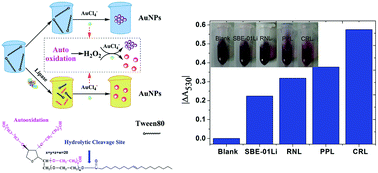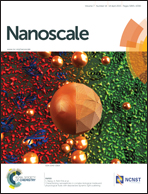A plasmonic nanosensor for lipase activity based on enzyme-controlled gold nanoparticles growth in situ†
Abstract
A plasmonic nanosensor for lipase activity was developed based on one-pot nanoparticle growth. Tween 80 was selected not only as the substrate for lipase recognition but also as the reducing and stabilizing agent for the sensor fabrication. The different molecular groups in Tween 80 could have different roles in the fabrication procedure; the H2O2 produced by the autoxidation of the ethylene oxide subunits in Tween 80 could reduce the AuCl4− ions to Au atoms, meanwhile, the lipase could hydrolyze its carboxyl ester bond, which could, in turn, control the rate of nucleation of the gold nanoparticles (AuNPs) and tailor the localized surface plasmon resonance (LSPR) of the AuNP transducers. The color changes, which depend on the absence or presence of the lipase, could be used to sense the lipase activity. A linear response ranging from 0.025 to 4 mg mL−1 and a detection limit of the lipase as low as 3.47 μg mL−1 were achieved. This strategy circumvents the problems encountered by general enzyme assays that require sophisticated instruments and complicated assembling steps. The methodology can benefit the assays of heterogeneous-catalyzed enzymes.


 Please wait while we load your content...
Please wait while we load your content...